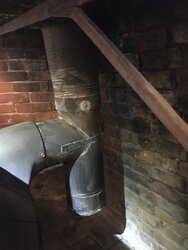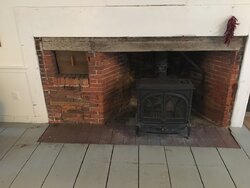After a million years of waffling around and spending my woodstove budget on other parts of the house, I finally got around to ordering a new stove (WS Absolute Steel-- thread to come). Now my issue is figuring out the details of remodeling my hearth and determining the health of my flue liner.
- I believe the flue liner is ~20 years old (to match the double door F400). It is uninsulated and runs ~24' from the cleanout to the chimney cap. For many of those years, it was cleaned from the top via metal brush and I've recently starting cleaning it from the bottom via a poly Sooteater. From what I can see when I clean it out, the liner appears to be in ok shape to my uneducated self. What kind of life should I be expecting from a liner? If it doesn't show signs of breaking down, is it still prudent to replace the liner for safety reasons based on age? Would installing a new, insulated liner give me a noticeable performance benefit over my existing set-up? I've attached a photo of the Tee to try to capture what looks like is maybe corrosion?
- The existing set up hasn't been up to snuff in regards to hearth floor fire protection and is definitely a project I'm relieved to be tackling. My plan here is to remove the square tiles and another ~20" of wood flooring and re-build with cement board and then brick tiles. Anyone see anything else I should be considering?
The AS will have a left-hand door and be rear vented.


- I believe the flue liner is ~20 years old (to match the double door F400). It is uninsulated and runs ~24' from the cleanout to the chimney cap. For many of those years, it was cleaned from the top via metal brush and I've recently starting cleaning it from the bottom via a poly Sooteater. From what I can see when I clean it out, the liner appears to be in ok shape to my uneducated self. What kind of life should I be expecting from a liner? If it doesn't show signs of breaking down, is it still prudent to replace the liner for safety reasons based on age? Would installing a new, insulated liner give me a noticeable performance benefit over my existing set-up? I've attached a photo of the Tee to try to capture what looks like is maybe corrosion?
- The existing set up hasn't been up to snuff in regards to hearth floor fire protection and is definitely a project I'm relieved to be tackling. My plan here is to remove the square tiles and another ~20" of wood flooring and re-build with cement board and then brick tiles. Anyone see anything else I should be considering?
The AS will have a left-hand door and be rear vented.







 )
)